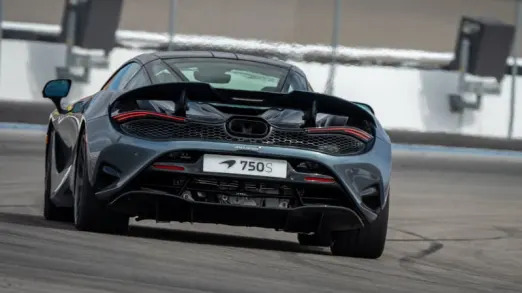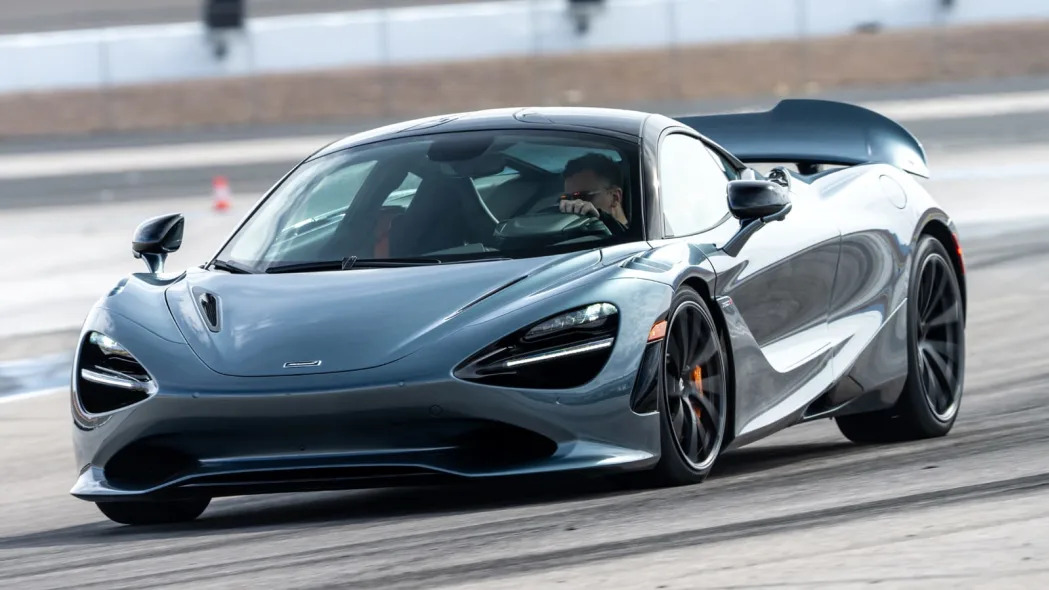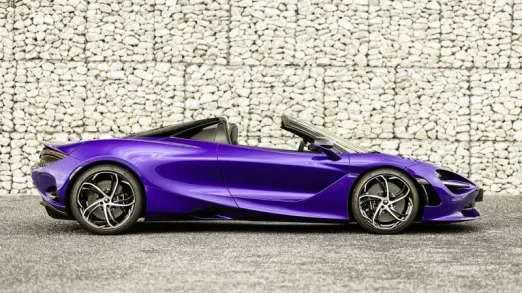
LAS VEGAS – The Valley of Fire just got several degrees hotter. The McLaren 750S Spider convertible I’m driving is spearing through the Nevada valley’s blushing outcrops of red Aztec sandstone, generating a pace so lurid that it might just rearrange the rocks in its fearsome path. The lonely Mojave Desert seems as good a place as any to engage launch control, hold tight to the Spider’s idyllically formed steering wheel, and experience what 740 horsepower feels like. A class-leading dry weight of 2,815 pounds gives the Coupe version the best power-to-weight ratio of any series-production McLaren yet, with the Spider just a bit below it on the pecking order with only about 100 pounds added.
Sixty miles per hour is dispatched so quickly (a company-tested 2.7 seconds) that there’s no time to mark its passing. An official 7.3 seconds to 124 mph (7.2 seconds for the Coupe) is more to the point; coincidentally right atop a Ferrari 296 GTB hybrid that delivers 79 more electrified V-6 horsepower, but weighs 425 more pounds by McLaren’s measure. A quarter-mile takes 10.1 seconds in the Coupe, or a top-down 10.3 seconds: Sizzling for sure, but here the Ferrari is quicker at 9.7 seconds, putting a thumb on the scale with its electric-motor boost. With every vein-popping accelerative burst, McLaren’s weight-saving exhaust testifies to a more stirring sound (versus the departed 720S) with every snort from its high-mounted nostrils.
The way McLaren engineers sweated the harmonic orders and crescendos of that stainless-steel exhaust – addressing the flat, uninspired voice that was really the only sensory failing of the 720S – underscores how the 750S is more than a mildly hotted-up 720S with 30 additional horses from a twin-turbocharged, 4.0-liter V8.
“We absolutely dialed up the fun factor of this car,” said Jamie Corstorphine, director of product strategy.
The car that McLaren conceived as a supercar with hypercar performance – including a straight-from-Senna “Track Brake Upgrade” pack with monobloc calipers (an extra $18,050) – also shows how well and quickly the brand has cemented its technical standing and market mindshare versus the veteran Ferrari and Lamborghini. The Woking, U.K., automaker known first for racing glory, including late founder Bruce McLaren’s record-setting CanAm run at Las Vegas’ mob-connected Stardust International Raceway in 1968, seems here to stay in the road-car business. Customer connection and enthusiasm shows in the 750S’ sold-out status through spring 2025. Over the 750S’ planned life cycle of 2.5 to 3 years, more than half the cars allocated to the Americas (90% of those in the U.S.) are already spoken for, with fewer than 900 left for potential owners.
I’m glad you asked: A 750S Coupe starts from $331,740, a Spider from $352,740. Those base prices are extra-base, even if one doesn’t choose, say, a $90,000 Gulf Oil livery, or carbon-fiber packs for the “Upper Structure” or “Underbody” at $17,800 a crack. A caloric schmear of 27 extra-cost options, including gorgeous Ceramic Gray paint from McLaren Special Operations ($9,900), lifted this particular Spider to $467,490. I lucked out to be assigned a Spider in this classy shade, which turned subtly lavender in certain light, and stood out even in a many-hued row of McLarens.
Changing its former overproducing ways, which led to shaky resale values for series-production cars, McLaren has largely switched to a customer-order philosophy. More than 80% of McLarens are now specced and pre-ordered by individual buyers, versus fewer than 50% four years ago. At Wynn Las Vegas, we visit a newly opened McLaren Experience Center, steps off the casino floor. The glass-fronted showroom hosts daily appointments for VIP prospects, who can sample the very F1 simulator used by McLaren driver Lando Norris, and a rotating display of cars that includes a rare McLaren Elva. The automaker estimates 20,000 people a day walk past and ogle candy-colored display cars — surely a few high rollers among them, who’d be better off buying a McLaren than blowing cash at poker or baccarat tables. Sure enough, the automaker says it has already sold 20 cars off this strategically located showroom floor.


No gambling is required on my drives in the Mojave Desert or at Las Vegas Motor Speedway, where the 750S combines irrational speed with reassuring poise. A car that already steered and handled beautifully in 720S form feels more vivid and easier to push to its limits. Or beyond, aided by a well-chosen Dynamic mode for stability control, or the Variable Drift Control that lets drivers set upper limits on yaw angle before the car sensibly reins things in.
On the tight 1.1-mile road course tucked into a NASCAR tri-oval, the McLaren immediately telegraphs its adhesive boundaries, even shod with track-centric Pirelli P Zero Trofeo R tires, versus standard P Zeros sampled on the road drive. (Non-R Trofeos are the middle-ground choice for wheels staggered 19 inches up front, 20 inches at the rear). Engineers cite gains in downforce and aerodynamic balance. After a half-dozen laps, I’m feeling frisky enough to dial back stability oversight, throttle-balance the car on howling tires, and catch one truly errant entry (“Nice save,” my chill young driving instructor offers from the shotgun seat) in a way I don’t recall from several track drives of the old 720S.
Standard carbon-ceramic brakes are appropriately heroic (front rotors measure 15.4 inches). They’re backed by an electrohydraulic assist from an active carbon-fiber rear wing that weighs 3.5 fewer pounds than the 720S’; despite flashing 20% more surface area for aero-enhanced braking, cornering downforce or drag reduction at superhero speeds. A new brake booster and vacuum pump aim to improve sensitivity and modulation. As ever, it’s great fun to storm past slower cars, and then watch the wing flip them off, so to speak, as it pops up to help shed speed. McLaren cites a 371-foot stopping distance from 124 mph, which it says is shorter than many supercars past or present.

Engineers say 30% of components are new versus the 720S. They cite three areas of focus for what they dub “the purist’s supercar”: More performance via increased power and torque, the latter rising 22 pound-feet to 590. Secondly, improving the 720S’ so-so driver interfaces and infotainment (a 12-speaker Bowers & Wilkins audio system adds $5,400). Apple CarPlay is now standard, but there’s no Android Auto. Finally, raising driver engagement and breadth of capability on street and circuits, but without dropping the baseline floor of comfort that’s become a McLaren signature.
Sandy Holford, the car’s chief engineer, said, “The challenge was to expand the bandwidth” of an already wildly capable 720S, “but without sacrificing any of the usability.”
Performance gains were achieved with a triple layer head gasket that allows increased cylinder pressures to generate power gains. There were then cooling improvements. A redesigned front bumper and splitter balance the effects of the enlarged rear wing, and feed fresh air to heat exchangers. Next-level aero concepts complement the 720S’ ingenious “eye-socket” headlamp cooling ducts and double-skinned doors that mask high-temperature radiator inlets. Rear deck vents and the rear bumper are reworked for improved cooling and reduced wheel-arch pressure. The 66-pound weight loss came by way of the lightened wing, available carbon-fiber shelled racing seats and the lightest wheels ever fitted on a series McLaren.


Comfort and control meet in the latest iteration of McLaren’s groundbreaking, linked-hydraulic suspension that eliminates anti-roll bars. The company’s all-hydraulic steering continues to defy today’s electric trend. It’s even faster and more-direct, and the car’s front track is widened by 6 mm. Springs with revised geometry are 3% softer in front, 4% stiffer in the rear, and 4.4 pounds lighter. The suspension gets revised tuning for its hydraulic accumulator. Engine mounts are redesigned for better response and engagement under acceleration. An improved hydraulic vehicle lift raises the front end over low-speed obstacles in 4 seconds, versus 10 seconds before.
But the biggest seat-of-the-pants change was reducing the 720S’ final-drive ratio by 15%, inspired by the brutal 765LT. That packs the McLaren’s Tyson-esque punch into more discrete wallops. Top speed drops from 212 mph to “only” 206 mph, but that’s meaningless compared with the payoff: The 750S leaps off the line with more alacrity, with snappier gearing for all seven forward speeds. Third gear peaks at right around 90 mph; fourth gear at 110 mph, and fifth gear at 140 mph. Common sense told me to stop right around there. A new ignition cut feature can halt spark to a single cylinder to elicit provocative pops and backfires from that finely tuned exhaust.
For price-unconscious buyers drawn to this special car, the Spider strikes me as the only way to go, at a mere $21,000 upcharge over the Coupe. For one, the company claims zero loss of chassis rigidity versus the Coupe, and again, it only packs on about 100 pounds thanks in part to a carbon-fiber upper roof structure. That top raises or lowers in 11 seconds, at speeds up to 31 mph. That came in handy when cigar-smoke clouds unleashed a sudden shower in the desert. An optional electrochromic panel darkens the top or makes it near-transparent. A rear backglass raises or lowers independently from the roof to let sweet sound inside. The roof’s stylish buttresses are cleverly formed from see-through composite to expand the rearward view. For its part, the Coupe integrates a double-glazed porthole window behind occupants, though all you really get is a peek at a small bit of intake plenum.




Swing the dihedral doors open, climb over fat carbon fiber door sills – abandon all hope of gracefulness, ye who enter here – and you’re ready for takeoff. A new column-mounted instrument display, similar to the Artura hybrid’s, is flanked by black plastic rocker switches to adjust powertrain and handling modes (Comfort, Sport, Track) without lifting hands off the wheel. A set of three buttons puts aero and launch controls in better ergonomic reach, with a “Speedy Kiwi” button to save macro settings. Yet compared with the cinematic command centers of some rivals — Ferrari manages both animations and a digitized take on its classic yellow tachometer — the McLaren’s smallish screen downplays the impending drama. Thin, pale fonts and presentations are no better than what you’d see in an electric Hyundai or Kia, and sometimes worse. In the powertrain’s Track mode, the rev counter becomes a tepid horizontal bar that stripes the upper screen, as compelling as a typical mpg display. Sure, the McLaren is so “unnecessarily fast,” in the words of a colleague, that keeping eyes glued on fast-approaching corners is the best strategy for exhilaration and self-preservation. But at these prices, a bit of digital fabulousness wouldn’t hurt.
The rest of the cabin lives out the fantasy, from enveloping seats to a waterfall center stack that houses an infotainment screen and transmission toggles. And it’s miles better than the fitful craftsmanship and clunky interfaces McLaren once delivered in cars like its inaugural 12C.
Coursing through the geological riot that is Lake Mead National Recreation Area, the McLaren keeps reminding me that park rangers do not consider racing to be “recreation.” On any road, this supercar’s comfort zone and speed limits have nothing in common. But with Lake Mead flashing blue in the distance, conjured into being by the mighty Hoover and Davis Dams, the park wraps 1.5 million acres: Almost enough for the mighty flow of the McLaren 750S.
Credit : Source Post




